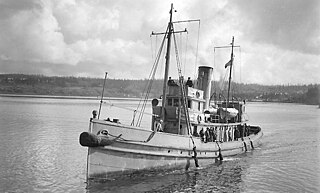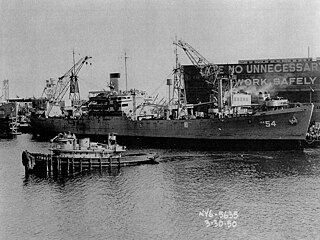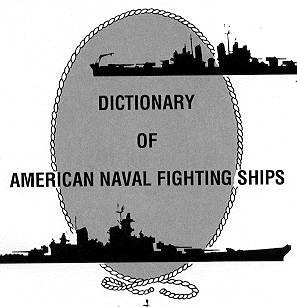 A drawing of Iona | |
| History | |
|---|---|
| Name: | Iona (YTB-220) |
| Builder: | Greenport Basin and Construction Company, Greenport, N.Y |
| Launched: | 26 August 1944 |
| Sponsored by: | Mrs. Martina E. Swanson |
| In service: | 2 February 1945 |
| Reclassified: | YTM-220 in February 1962 |
| Out of service: | May 1963 |
| Fate: | Burnt in June, 1963, following sinking in May. |
| General characteristics | |
| Class and type: | Cahto-class district harbor tug |
| Displacement: | 410 long tons (417 t) |
| Length: | 110 ft (34 m) |
| Beam: | 27 ft (8.2 m) |
| Draft: | 11 ft (3.4 m) |
| Speed: | 12 knots (22 km/h; 14 mph) |
| Complement: | 12 |
| Armament: | 2 × .50-caliber machine guns |
Iona (YT/YTB/YTM-220), a wooden tugboat originally classified YT-220, was launched by Greenport Basin and Construction Company, Greenport, New York, 26 August 1944; sponsored by Mrs. Martina E. Swanson; and placed in service 2 February 1945. She was the second United States Navy ship of that name.

A tugboat is a type of vessel that maneuvers other vessels by pushing or pulling them either by direct contact or by means of a tow line. Tugs typically move vessels that either are restricted in their ability to maneuver on their own, such as ships in a crowded harbor or a narrow canal, or those that cannot move by themselves, such as barges, disabled ships, log rafts, or oil platforms. Tugboats are powerful for their size and strongly built, and some are ocean-going. Some tugboats serve as icebreakers or salvage boats. Early tugboats had steam engines, but today most have diesel engines. Many tugboats have firefighting monitors, allowing them to assist in firefighting, especially in harbors.
The Greenport Basin and Construction Company, known by various names throughout its history, but most recently named the Greenport Yacht & Shipbuilding Company, is a shipbuilder in Greenport, Suffolk County, New York. It was established in the 19th century by brothers Pliny C. Brigham and Theodore W. Brigham. One local history relates:
Greenport prospered due to the menhaden industry; 64 boats were in service and seven under construction in 1879. By this time, shipbuilding boomed in Greenport. The Greenport Basin and Construction Company, famous yacht builders, became a large repair and docking facility for menhaden vessels. Menhaden vessels or "bunker boats" were said to have lined the shoreline along Main and Front Streets.

Greenport is a village in Suffolk County, New York, United States. It is on the north fork of Long Island. The population was 2,197 at the 2010 census.
The new tug was assigned harbor duty in the 14th Naval District based at Pearl Harbor, and she remained there until transferred to the Philippines in 1955. At Subic Bay Iona performed harbor duties necessary for the smooth functioning of a great naval base. She was reclassified a 'District Harbor Tug Medium', YTM-220, in February 1962. In June, 1963, following an accidental sinking in May, she was disposed of by burning.

Pearl Harbor is a lagoon harbor on the island of Oahu, Hawaii, west of Honolulu. It has been long visited by the Naval fleet of the United States, before it was acquired from the Hawaiian Kingdom by the U.S. with the signing of the Reciprocity Treaty of 1875. Much of the harbor and surrounding lands is now a United States Navy deep-water naval base. It is also the headquarters of the United States Pacific Fleet. The U.S. government first obtained exclusive use of the inlet and the right to maintain a repair and coaling station for ships here in 1887. The attack on Pearl Harbor by the Empire of Japan on December 7, 1941, was the immediate cause of the United States' entry into World War II.

The Philippines, officially the Republic of the Philippines, is an archipelagic country in Southeast Asia. Situated in the western Pacific Ocean, it consists of about 7,641 islands that are categorized broadly under three main geographical divisions from north to south: Luzon, Visayas, and Mindanao. The capital city of the Philippines is Manila and the most populous city is Quezon City, both part of Metro Manila. Bounded by the South China Sea on the west, the Philippine Sea on the east and the Celebes Sea on the southwest, the Philippines shares maritime borders with Taiwan to the north, Vietnam to the west, Palau to the east, and Malaysia and Indonesia to the south.

Naval Base Subic Bay was a major ship-repair, supply, and rest and recreation facility of the Spanish Navy and subsequently the United States Navy located in Zambales, Philippines. The base was 262 square miles, about the size of Singapore. The Navy Exchange had the largest volume of sales of any exchange in the world, and the Naval Supply Depot handled the largest volume of fuel oil of any navy facility in the world. The naval base was the largest overseas military installation of the United States Armed Forces after Clark Air Base in Angeles City was closed in 1991. Following its closure in 1992, it was transformed into the Subic Bay Freeport Zone by the Philippine government.













